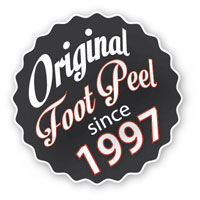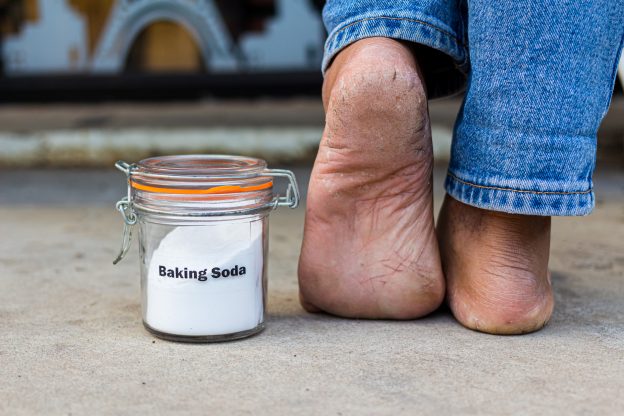The dreaded foot callus. Why is it there? Where did it come from? And most importantly, how do you get rid of it? Read on to learn how to get rid of calluses!
For some, learning to remove foot calluses can be as tough as the calluses themselves. Taking on these formidable foes is one of humankind’s longest-running grudge matches, but it’s one you can win. There are plenty of ways to remove calluses out there, but finding the most effective one may require some trial and error.
Old-fashioned elbow grease is the most labor-intensive method—just grab a handheld file or pumice stone and start grinding away. If you’re looking for a less strenuous approach, though, there are a number of retail and home callus removers that can safely break down the coarse skin with mild chemicals.
Below are four of the best ways to safely remove foot calluses, but first, here’s the 411 on these stubborn sole crushers.
What is a Callus on Your Feet?
Much in the way that your internal immune system leaps into action to fight infection, your feet have their own defense mechanism—calluses.
Like your palms, the bottom of your feet are tender. And the thinner, more pliable skin on your soles takes a beating. Calluses occur when the outer layers of skin try to protect an underlying area from pressure or friction often caused by walking or standing for long stretches. Calluses are typically found on the heels or balls of your feet. They can be rough and unsightly but are generally harmless. That said, they can also be a source of discomfort or even pain. If that’s the case, you should see a podiatrist. Interestingly, women are also more prone to calluses than men.
What Causes Calluses to Build Up on Your Feet?
Calluses can begin to build up on your feet for a variety of reasons. If your shoes don’t fit properly or you have sweaty feet, you’re even more susceptible to these buggers. Knowing the cause of calluses is half the battle. Below you can find the most common causes of foot calluses:
- Medical conditions like arthritis affect the normal alignment of the bones in your feet
- Walking barefoot, without socks
- Ill-fitting shoes and socks
- Standing, walking, or running for long periods
- Walking with poor posture
- Wearing shoes without socks
- Smoking
For those who suffer from foot calluses, there are several ways that you can remove them with relative ease. If you’re interested in learning more about foot callus removal, then read on.
Get Rid of Calluses with the Baby Foot Exfoliating Peel
If you want an affordable, safe callus remover that does all the work for you, then try our exfoliating foot peel. Don’t take our word for it. Multiple media outlets have picked our peel as their hands-down favorite for effortlessly getting rid of calluses.
Earlier this year, Good Housekeeping named our peel the “Best Callus Remover for Feet.” So what do they love most about the Original Exfoliant Foot Peel? That most people see results in just a few days. Byrdie also recently included our peel in its list of best callus removers.
Our scientifically formulated foot peels contain 16 natural extracts that exfoliate and moisturize at the same time. Fruit acids, such as glycolic acid and citric acid, penetrate layers of dead skin cells and break down desmosomes, which hold those layers together. The salicylic acid, lactic acid and isopropyl then trigger a flaking effect.
If you’re in the mood to kick your feet up for an hour and watch your calluses disintegrate before your very eyes, our peel won’t disappoint. Just slip on the gel-filled booties and bid those loathsome lumps adieu. Just don’t forget to try our Moisturizing Foot Mask after your peel to make sure your feet stay hydrated and healthy.
Use a Homemade Paste to Erode Calluses
If you’re a fan of home remedies, then you’re well aware of the wonders of baking soda. Unsurprisingly, baking soda is the central ingredient in a homemade paste that’s good for getting rid of calluses.
Known for its gentle properties, baking soda makes this paste a great callus remover
if you have sensitive skin. Just add baking soda to two tablespoons of water until it thickens into a paste, then add a few drops of lemon or lime juice. Use a large popsicle stick to coat the calluses and then cover your feet with socks or an elastic bandage wrap. Let the paste work overnight and repeat nightly until those calluses are kaput.
If the idea of gooping your feet up with a paste is too icky, here’s a variation that’s more of a soak. You can also use aspirin to make a paste if you don’t have any baking soda, but it’s a bit messy and will cut into your supply of headache meds.
Apply Medicated Patches to Wear Down Calluses
Peels and pastes definitely require a time investment. Perhaps you’re looking for a more effortless solution. Medicated patches or pads are a good alternative if convenience is what you value most.
Over-the-counter adhesive patches are widely available at drug stores and extremely easy to use. These patches typically contain salicylic acid—also used to treat plantar warts—to break down calluses over time. Much like a medicated bandage for a cut, the patches are applied directly to the calluses. Leave them on for hours and let them work their magic!
We recommend Dr. Scholl’s, a company that’s been selling foot-focused wellness products for more than 100 years. Their medicated discs will often soften up the thickest calluses in just a few days.
Grind Calluses Down with a Pumice Stone
For granite-like calluses that seem impervious to chemical treatments, you may need something a bit cruder. And by that, we mean scraping away at that juggernaut with a pumice stone until the dead skin finally sloughs away.
Pumice is a porous volcanic rock that forms when lava cools so rapidly there’s no time for it to crystallize. The result is a lightweight-yet-heavy-duty scrubber for your feet. As far back as 600 B.C., Roman women used pumice stones to remove body hair, according to the Women’s Museum of California. They were later adapted as natural exfoliators ideally suited for smoothing out the soles of our feet.
There’s more than you might think to choosing the right pumice stone for your feet. But once you do, you’ll be able to get rid of the toughest of calluses through diligence and perseverance. Each day, gently rub the stone in a circular motion or from side to side to buff away those bulbous burdens.
Whichever method you choose for removing foot calluses, we wish you all the best in your quest for softer feet!


